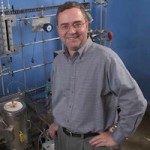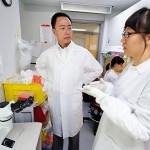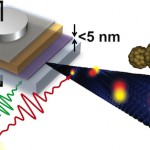Tag College of Engineering
Control theorist Barmish challenges need to model financial markets
B. Ross Barmish hopes his research will build a bridge between control theorists and financial scholars. Barmish, a professor of electrical and computer engineering at UW–Madison, posits that not only are predictive models of financial markets unreliable, but also that stock traders can do without predictive models, simply by applying control theory to the markets.
Wisconsin engineer honored for ongoing innovation
Corn may be a dietary staple for humans and animals around the world, but in Jim Dumesic's eyes, the plant "waste" left after the harvest holds even more potential as a renewable bio-based source of fuels and important chemicals. On Dec. 10, the National Academy of Inventors (NAI) named Dumesic, the Steenbock professor and Michel Boudart professor of chemical and biological engineering at the University of Wisconsin–Madison, among 143 leading innovators elected to its 2013 class of fellows.
Engineers explore ways to understand, outwit blood-brain barrier
MADISON — With support from the New Frontier Science group of Takeda Pharmaceutical Co., University of Wisconsin–Madison engineers are conducting innovative research that could open…
Discovery sheds light on how changes in lungs can hurt the heart
A team of University of Wisconsin–Madison researchers has discovered important biomechanical changes in human arteries that could increase understanding of how pulmonary hypertension leads to heart failure.
Two honored for advancing status of UW women
Lynn Edlefson, campus child care coordinator and director of the Office of Child Care & Family Resources, and Steve Cramer, associate dean for academic affairs of the College of Engineering, are the recipients of this year’s Women's Philanthropy Council (WPC) Champion Awards at UW–Madison.
Astronaut scholarship honors undergrad’s adventures in research
Even in the University of Wisconsin–Madison College of Engineering, where undergraduates are encouraged to seek hands-on experience, it’s rare that a faculty member finds himself taken aback by a freshman’s eagerness to get involved in research.
The chemistry of color: Energy researcher develops dye-based solar cells
University of Wisconsin–Madison researchers working at the intersection of basic and applied science focus on key factors like cost, environmental impacts ... and sometimes, color.
Waisman scientists model human disease in stem cells
Many scientists use animals to model human diseases. Mice can be obese or display symptoms of Parkinson's disease. Rats get Alzheimer's and diabetes. But animal models are seldom perfect, and so scientists are looking at a relatively new type of stem cell, called the induced pluripotent stem cell (iPS cell), that can be grown into specialized cells that become useful models for human disease.
Innovation institute to broaden U.S. palette of advanced materials
Sporting sleek cases, sensitive touch screens, and an ever-increasing array of features, today's smartphones and tablets provide consumers unparalleled mobile computing capability.
RFID advance to improve safety of nation’s blood supply
A six-year collaboration between industry and the University of Wisconsin–Madison RFID Lab has achieved a major milestone with the Food and Drug Administration (FDA) clearing the first RFID-enabled solution to improve the safety and efficiency of the nation's blood supply.
Road block: Fixing aquatic ecosystem connectivity doesn’t end with dams
Over the last several years, state agencies and environmental nonprofit organizations have targeted dam removal as a way to quickly improve the health of aquatic ecosystems. Dams keep migratory fish from swimming upriver to spawn, block nutrients from flowing downstream, and change the entire hydrology of a watershed. From an ecosystem perspective, taking down a dam and returning a river to a more natural flow seems like a no-brainer.
Early career award funds study of messenger RNA stability
In an effort to improve microorganisms that can sustainably produce fuels and chemicals, a University of Wisconsin–Madison engineer is using a U.S. Department of Energy award to study what - if anything - gets lost in the translation of genetic information.
Advanced manufacturing focus of June 10-14 conference
Featuring a broad swath of leading-edge research from around the world, an advanced manufacturing research conference June 10-14, 2013, will draw nearly 500 academic, industrial and governmental participants to the Monona Terrace Community and Convention Center in Madison.
Chemical engineer receives prestigious Korean honor
Sangtae Kim, who has held both faculty and leadership positions at the UW–Madison, has received the 2013 Ho-Am Prize in Engineering, the highest honor from South Korea for research accomplishments in science, engineering, technology and math fields.
Production process doubles speed and efficiency of flexible electronics
Stretched-out clothing might not be a great practice for laundry day, but in the case of microprocessor manufacture, stretching out the atomic structure of the silicon in the critical components of a device can be a good way to increase a processor's performance.











